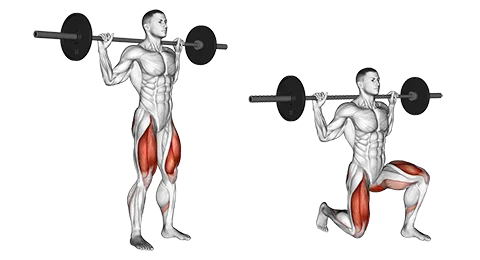Introduction
The Barbell Lunge is a compound lower body exercise that primarily works on leg strength and balance. It involves stepping forward with one foot while holding a barbell across your back, then lowering and returning to the starting position. This movement targets the quadriceps, hamstrings, glutes, and calves, making it an excellent exercise for building lower body power and improving overall stability. The Barbell Lunge is particularly effective for individuals seeking to improve athletic performance or achieve well-defined leg muscles.
Muscles Worked
- Primary: Quadriceps (thigh), Gluteus maximus (buttock)
- Secondary: Hamstrings (back of thigh), Calves, Abductors (outer thigh), Adductors (inner thigh), Core muscles
How to Do It (Step-by-Step)
- Stand with feet hip-width apart, holding a barbell across your upper back with an overhand grip, hands just wider than shoulder-width apart.
- Step forward with one foot (lunge), keeping the front knee directly above the ankle and ensuring it does not extend past the toe; lower until the rear knee nearly touches the floor.
- Press through the heel of the front foot to return to starting position, then repeat with the opposite leg. Essential checkpoints: maintain a neutral spine, engage your core, and keep your weight centered over the working foot during each lunge.
Tip: If using a barbell is too challenging, start with bodyweight lunges or use dumbbells instead to build strength before progressing to a barbell.
Rep & Rest Guidelines
- Strength: 4–6 reps, 2–3 min rest
- Hypertrophy: 8–12 reps, 60–90 sec rest
- Endurance: 12–20 reps, 30–60 sec rest
Auto Progression helps you adjust weights automatically.
Rest Timer ensures accurate rest intervals for optimal performance.
Form Tips
- Maintain an upright torso and keep your core engaged throughout the exercise.
- Step forward with one foot, keeping the front knee directly above the ankle, and lower until the rear knee nearly touches the ground. Then, push through the heel of the front foot to return to a standing position. Repeat for the other leg.
- Avoid leaning too far forward or back during the lunge. Keep your weight evenly distributed between both feet throughout the movement.
When to Use It
- Strengthening Lower Body Muscles: Barbell lunge effectively targets the quadriceps, hamstrings, glutes, and calves for better lower body strength and muscle growth.
- Improving Balance and Coordination: Performing barbell lunges can help enhance overall balance and coordination due to the unilateral nature of the exercise.
- Functional Fitness Training: Incorporating barbell lunges into functional fitness routines helps improve everyday movements such as climbing stairs, jumping, or squatting.
Workout History keeps a record of all your workouts for future reference and progress tracking.
Barbell lunges primarily target the quadriceps, glutes, and hamstrings.
A good starting point is 3-4 sets of 8-12 reps per leg.
Choose a weight that allows you to complete the desired number of reps while maintaining good form.
If you have knee issues, consult a healthcare professional before attempting barbell lunges or other high-impact exercises.
Both forward and backward lunges are effective. Choose the variation that feels most comfortable for your body.

